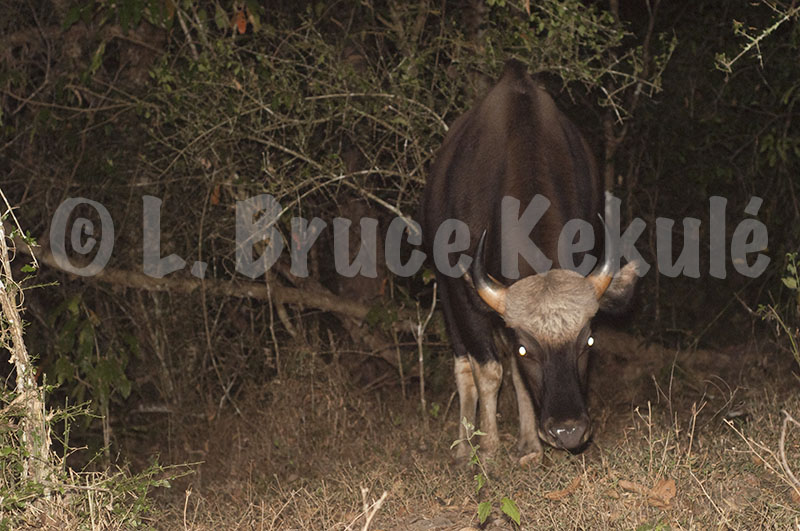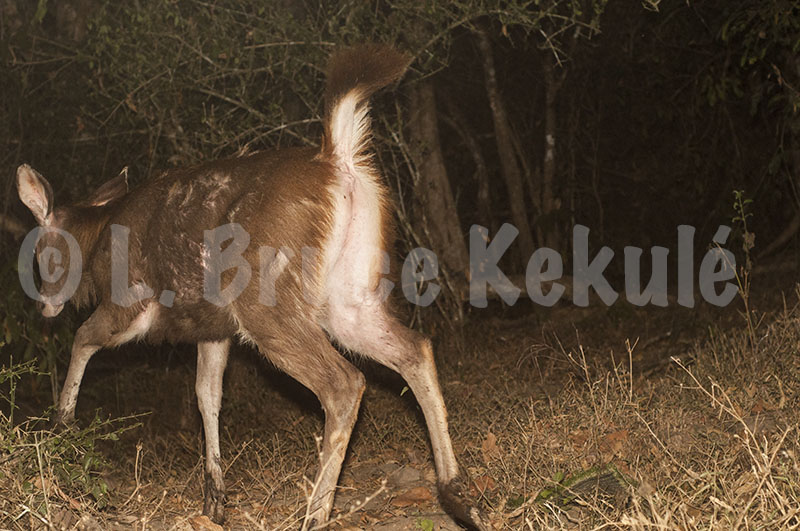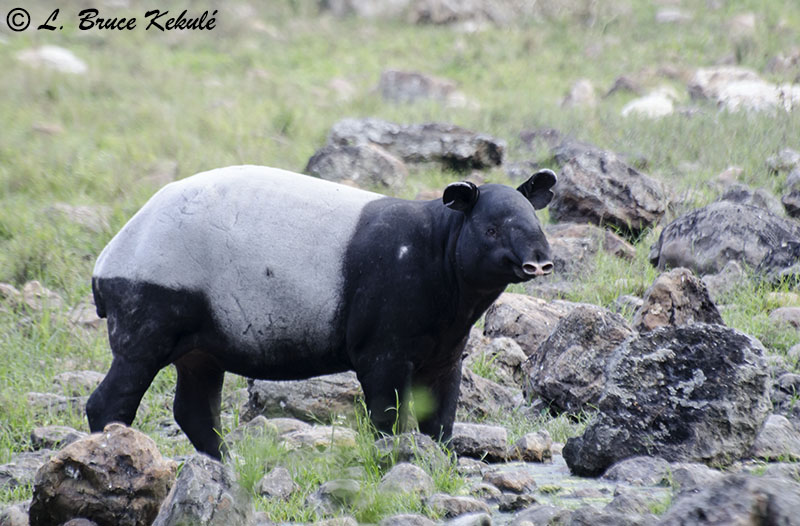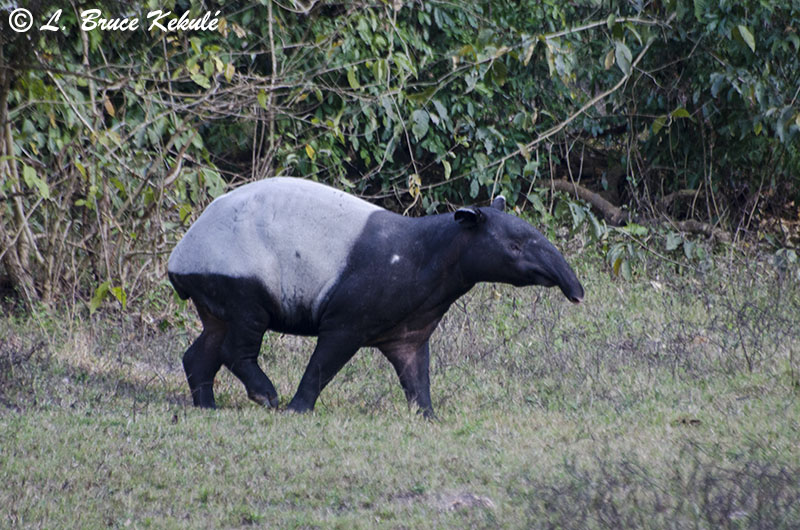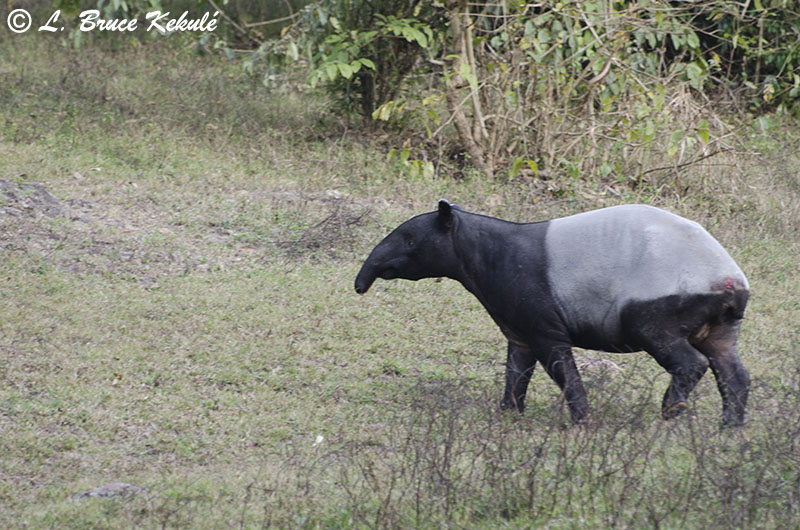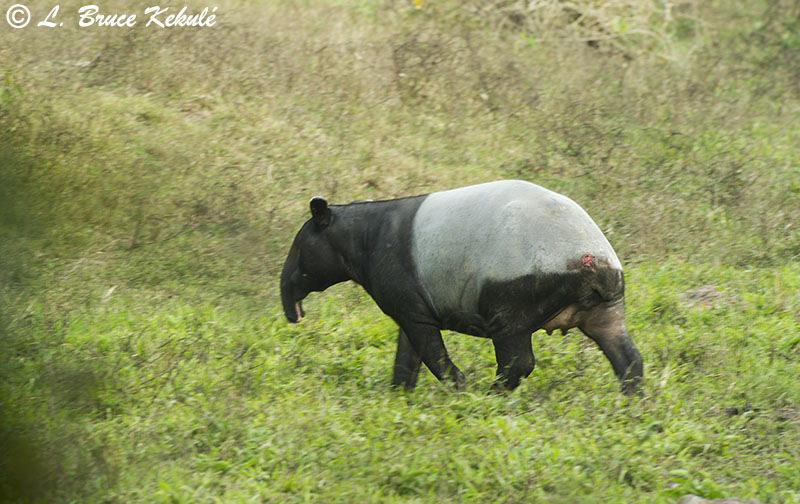Posts Tagged ‘tapir’
Gash – An old Asian Tapir female..!
My Nikon D700 catches an odd-toed ungulate near a hot spring in the ‘Western Forest Complex’
An old Asian tapir female with a gash on her left flank…!
Before my trip to the U.S.A. this year in May, I set a Nikon D700 DSLR trail cam near a hot-spring in the ‘Western Forest Complex’ of Thailand. My first capture was an Indochinese female tiger shown below. But a real bonus was catching an Asian Tapir quite a few times usually leaving the waterhole after drinking the important minerals that seep from a rocky outcrop just down from this location.
Caught again later the same night…does look like she’s been through a meat-grinder…!
The ‘gash’ on it’s left flank is probably caused from a tiger’s claws trying to catch it but not being able to hold on. Tapir have extremely thick hide, and are very agile and fast and can shake-off a tiger. I have seen many tapir with these blood markings. Needless to say, a tribute to the tenacity of this rare species and a lucky catch on my Nikon D700…!
A female tiger camera trapped a few days before the tapir above…!
When it rains tapir, it pours tapir…!
A rare late afternoon capture of an Asian tapir Tapris indicus
A female tapir at a mineral hot spring in the Western Forest Complex of Thailand…!
Recently (Nov. 2014), I caught a female tapir that looked pregnant on my Canon 400D trail cam down in Southern Thailand at Khlong Saeng Wildlife Sanctuary located in Surat Thani province far off the beaten track.
First shot coming down the hill …!
The site is 60 kilometers by boat into the protected area. I got some really nice shots of the odd-toed ungulate as it moved along a wildlife trail on a ridgeline down to the reservoir. Also got a beautiful clouded leopard even though it was a bit out of frame. I counted my lucky stars…!
I have named this old girl ‘White Spot’ seen on her right shoulder…!
Then, I went back to Bangkok for some rest and after a few days, decided to go into my favorite protected area in the ‘Western Forest Complex’ to check and set-up a couple trail cams, and to sit in a photo blind where I got a black leopard 16 years ago, and then again in 2013.
What a pose with her rear leg extended just like a pedigree dog…!
I recently missed a black cat here when my Nikon 400 ƒ2.8 lens went on the blink in November last year. In 2010, I camera trapped a tapir in the morning just down from the blind. It has been a marvelous place and I have caught many species of Asian wildlife through the lens and by camera trap that come to the hot spring.
She must have heard me rustling in the leaves…!
As I was setting up my Canon 400D trail cam below the photo-blind, I got a bit frustrated as the camera would not trip after setup and so I left it. I was only 15 meters away from the blind. Somehow, I had nudged the control button to ‘Auto’ as I was to find out the next day.
And she high-tailed back up the hill but stopped short and came back down…!
I got five-steps, and there stood a female tapir out in the open coming down the hill to the hot spring. As I always carry a Nikon D7000 and a 70-300mm VR lens, I immediately started shooting.
Making her way back down to the mineral hot spring…!
I was also out in the open but as she looked the other way, I moved a little bit closer to get to my big lens (Nikon D3s and 200-400mm VR II) sitting on a tripod ready for action.
Still has not seen me…!
Tapir have very poor eyesight but hearing and smell are good. She must have heard me as she bolted back up the hill. She stopped short and then came back down. I was still shooting with the D7000. I finally got into the blind and started shooting the big camera. It was very exciting to see this odd-toed ungulate as they are nocturnal for the most part and hardly ever seen in the day.
A female for sure and a large wound on her rump: maybe a tiger or leopard, or wild dogs…!
I know of someone who has spent many years trying to photograph this species with no luck. He once spent 10 days at this hide unsuccessfully and then at another location for eight days. He left the sanctuary in despair and has been chasing them ever since..!
The moral of this story: Have a camera over your shoulder at all times if you are in the forest working or traveling through. You never know when something might pop out…I learned this from a National Geographic staff photographer (William ‘Bill’ Albert Allard) when he was here in Thailand as we chased down domestic elephants for a story in N.G. magazine…!
He said: “if you don’t have a camera, you aren’t going to get a shot”. It was a neat job and the pay was great. But it was the knowledge and ‘tricks-of-the-trade’ I picked up from him that has really paid off over the years. I think he took a shower with a camera around his neck..! Needless to say, I always have one ready just in case. I might have missed this tapir if I had left it up in the blind…! Enjoy
Canon 400D catches an old Asian tapir and clouded leopard
Southern Thailand’s natural heritage – an odd-toed ungulate and a carnivore
A mature Asian tapir caught by a Canon 400D trail cam…!
Just returned from Khlong Saeng Wildlife Sanctuary in the south of Thailand and pulled my Canon 400D camera trap. These shots are of an old Asian Tapir and the best ones in this set as shown here. Being odd-toed ungulates and strictly vegetarian, these large herbivorous mammals thrive quite well in this unique ecosystem made up of moist evergreen forest. These unique creatures have been on the planet for about 40 million years. They are the largest of the world’s four species with the other three in South America…!
This tapir almost looks pregnant…!
A clouded leopard in daylight…!
This cam also caught a clouded leopard but the cat came in a bit low. These cats are not normally out in broad daylight but I guess they do sometimes prowl during the day. That was the trade off for the full-frame tapir shot. This sanctuary is simply amazing and I look forward to future visits…! Enjoy…!
Living Fossils – A video of Asian tapir
Rare daytime footage of Asian Tapir
Tapir are considered living fossils as the genus has been traced back as far as Early Oligocene times. These remarkable mammals have been on the planet for about 40 million years. The first tapirs are named Miotapirus judging from fossil evidence found in North America. Tapiridae, a sub-family belong to the Order Perissodactyls, or odd-toed ungulates that goes back to the Late Paleocene 55 million years ago including rhinoceros-like creatures evolving in North America and eastern Asia from small animals similar to the first horses.
The Asian tapir Tapirus indicus, also called the Malayan tapir, is the only one native to Southeast Asia. It has an unmistakable black and white two-tone pattern distinguishing it from the other three tapir species of Central and South America. The Asian species is the largest, and is the only ‘Old World’ tapir with the females usually slightly larger than the males. They live in the rainforests of Thailand, Myanmar, Malaysia and Sumatra.
This old male and female tapir visited this site more than once over two days. Most of the footage was captured by a Bushnell HD Trophy Cam, and the IR clip by a Ron Davis DXG 125v IR homebrew cam.
Chasing a Wild Dream
A video about Thailand’s Amazing Wildlife in the Western Forest Complex. From wild elephants to green peafowl, this film shows the world the wildlife in the Kingdom’s protected areas, and the need to save this wonderful natural heritage for present and future generations to come.
In the heart of Southeast Asia, the Kingdom is blessed with some of the best and last remaining examples of Asian animals and ecosystems that harbor the tiger, leopard, elephant, gaur, banteng, wild water buffalo, tapir, sambar, muntjac, gibbon, green peafowl, hornbill, plus thousands of other amazing creatures and biospheres that have evolved over millions of years and show-case Mother Nature and her magnificent beauty…!













